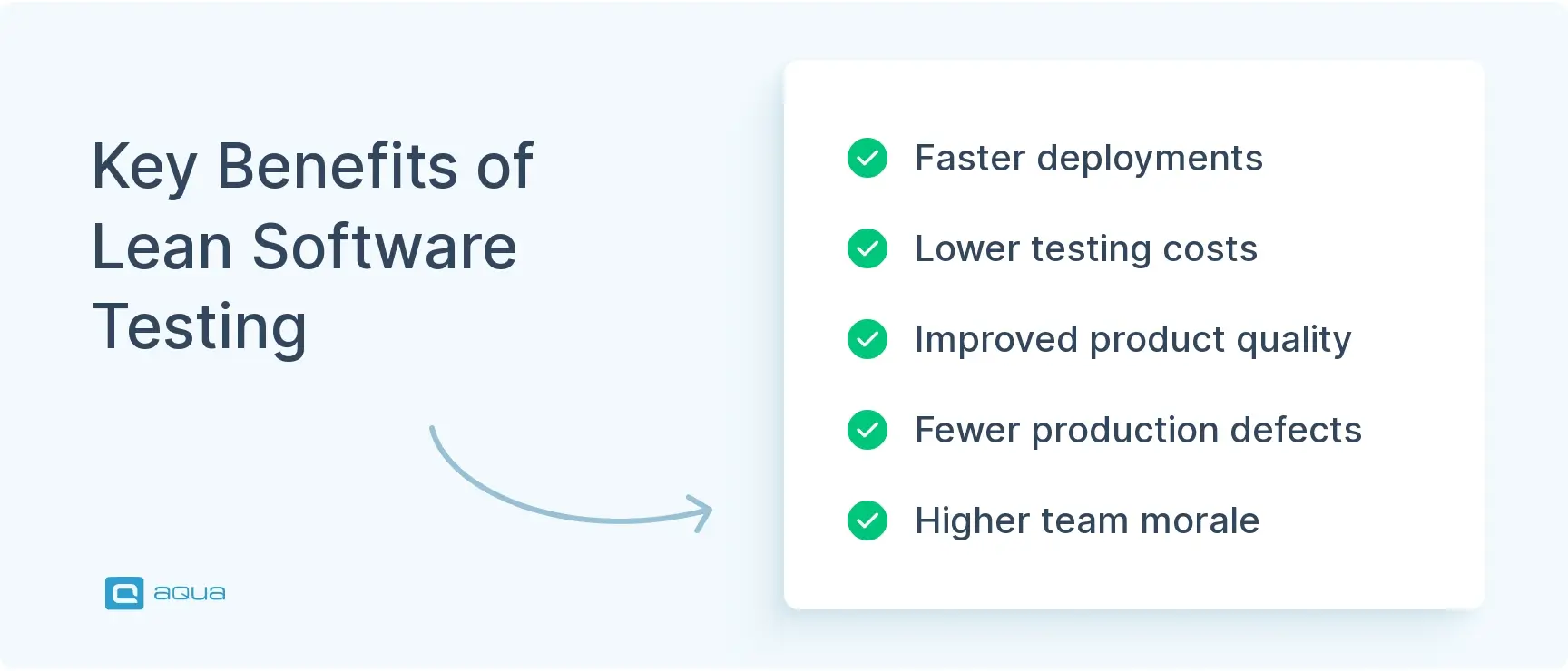Key Takeaways
- Lean software testing maximizes customer value while minimizing waste, focusing on tests that validate key user journeys and high-risk areas rather than attempting comprehensive coverage.
- Organizations implementing lean testing deploy code 46 times more frequently than their peers, while finding and fixing bugs earlier costs less than addressing them after release.
- The lean testing approach builds quality throughout development instead of treating testing as a separate final phase, incorporating practices like TDD, continuous integration, and automated feedback loops.
- Lean testing implementation requires mapping your value stream, eliminating waste, right-sizing test automation, and establishing metrics that measure outcomes rather than test case counts.
- Lean testing aligns perfectly with agile and DevOps practices, enabling continuous feedback and integration. Teams that embed testing into every development stage experience 60% fewer defects in production and significantly higher deployment confidence.
Tired of experiencing hours of QA delays, while release cycles stretch from days into weeks? Lean testing offers to balance optimal speed with desirable outcomes, without compromising conventional approaches. Discover how lean principles transform testing from a development bottleneck into a strategic advantage.👇
What is Lean Testing?
Lean software testing is essentially a concept of testing smarter. Or, in other words, ensuring every test has purpose and the quality is integrated throughout the development process rather than treating QA as a separate phase of the development cycle.
The concept originated from Toyota’s Production System and was later adapted to software development by Mary and Tom Poppendieck in their work on lean software development. In testing specifically, lean methodology in software testing focuses on identifying what truly adds value to the customer and eliminating activities that don’t contribute to that value.
As such, a lean test is characterized by several key attributes:
- It directly validates customer value or mitigates meaningful risk
- It provides quick, clear feedback
- It avoids duplication of test coverage
- It’s maintainable and reliable
- It’s integrated into the development workflow
For example, instead of writing extensive test documentation upfront that may become outdated, a lean approach might use just-in-time test charters that focus testers on exploring high-risk areas. Or rather than maintaining thousands of UI-level tests that run slowly and break often, a lean strategy might emphasize a robust foundation of unit and API tests with a smaller set of critical UI tests.
At the moment, we have a heavy reliance on writing test cases held in a test management tool even though we work in agile and quite lean environment. Once written they are very rarely re-used and are not currently read by the rest of the team.
Comparison of lean testing and traditional testing
Since you’ve already explored the lean testing concept, let’s compare it against the traditional testing approach for a complete insight:
| Aspect | Traditional Testing | Lean Testing |
|---|---|---|
| Planning | Comprehensive test plans created upfront | Lightweight, evolving test strategy based on risk and value |
| Documentation | Extensive test cases and detailed scripts | Minimal documentation focused on intent and critical scenarios |
| Timing | Testing as a separate phase after development | Testing integrated throughout development cycle |
| Scope | Attempt to test lean | Risk-based approach prioritizing high-value areas |
| Automation | Often heavy UI automation | Balanced pyramid with emphasis on unit and API testing |
| Feedback Loop | Longer feedback cycles | Fast feedback through continuous testing |
| Team Structure | Specialized QA teams | Cross-functional ownership of quality |
| Metrics | Test case counts and coverage | Value delivery and defect prevention |
| Change Response | Resistance to requirement changes | Embraces change through adaptability |
| Waste Management | Limited focus on eliminating waste | Actively identifies and eliminates non-value activities |
The change from traditional to lean testing means changing how you think about quality. Testers know well that traditional approaches focus on comprehensive documentation and following processes to the letter. Lean testing, on the other hand, prioritizes what matters to your customers, getting feedback quickly, and improving as you go.
Why Lean Testing Matters
After seeing how lean testing differs from traditional approaches, you might wonder if the change is worth the effort. Let’s look at what actually happens when teams make this shift.
Picture your current testing cycle. How long does it take to validate a release? Days, or maybe even Weeks? Lean testing changes this equation. You can eliminate redundant test cases and automate the right checks at the right levels. As for the result: According to DevOps Research and Assessment (DORA) research data, organizations with mature testing practices deploy code 46 times more frequently than their peers with less optimized approaches.
The cost implications are equally significant. Traditional testing often involves substantial overhead. At the same time, lean testing works differently. With this methodology, you invest testing effort where risk is highest, and, respectively, indicate more defects in development when they’re cheaper to fix.
But here’s what may come as a surprise: lean testing actually strengthens quality rather than undermines it. That’s because you’re building quality checks directly into the development process.
The best part is that these improvements compound over time. Faster feedback loops help developers learn what breaks the system. Better quality reduces rework and technical debt. Due to that, the entire team gains confidence in their ability to deliver. This sets the stage for the next critical question: what exactly should you test when every test needs to earn its place?
When you apply lean testing tutorial, the right tools make the difference between wasted effort and true efficiency. That’s where aqua cloud’s test management platform plays a key role. It centralizes all testing assets in one place, removes fragmentation, and eliminates redundancy and miscommunication, which are the two major sources of waste. With 100% traceability and requirements management, teams align development and testing without friction. Moreover, aqua generates test cases from requirements in seconds and integrates with Capture for visual bug reports. Both complete coverage and faster feedback loops are ensured. Together with Jira, Azure DevOps, and Confluence integrations, aqua delivers a connected testing environment that truly takes away the pain of testing.
Eliminate 75% of testing waste and accelerate delivery by 70% with a lean testing approach
What should be tested under lean testing?
As mentioned multiple times previously, lean testing means testing smarter by focusing on what truly matters. That’s why, when choosing a lean testing tool, you should be able to identify the highest value test targets that will give you the most confidence with the least effort.
Your first priority should always be core functionalities that directly support the primary user journeys. What are they? For an e-commerce site, this might include the search function, checkout process, and payment system. For a content platform, it might focus on content creation, publishing workflows, and user engagement features. Every non-essential functionality should have a lower priority for testing.
Another key point is that risk-based testing is central to lean approaches. By looking at where the biggest risks are, teams can allocate testing resources proportionally. This means more testing for high-risk areas like complex business logic or critical security systems, and less for stable, low-impact components.
Additionally, you can’t overlook performance and security, but you need to approach these concerns intelligently. Rather than running comprehensive performance tests, focus on your likely vulnerabilities and critical user paths. At the same time, when it comes to security testing, prioritize your data-sensitive areas and components with external interfaces instead of trying to cover everything equally.
Examples of what to prioritize in lean testing include:
- Critical user flows that generate revenue or define core user experience
- Integration points between systems where failures often occur
- New features or recently modified code that carries a higher risk
- Edge cases that have historically caused problems
- Error scenarios and recovery processes for critical functions
- Cross-browser/device compatibility for key user journeys (not every screen)
A lean approach to testing requires ongoing refinement based on real-world feedback. Usage data, production monitoring, and customer feedback should continuously inform what gets tested and how thoroughly
If you’re trying to deformalise, move down the chain. Leverage checklists and charter notes, and/or start taking screen recordings. The idea is to keep only what’s useful and/or make it cheaper.
Core Principles of Lean Testing
The foundation of lean testing was derived from lean manufacturing and adapted to software development. Understanding and applying these lean software testing principles can help to get rid of vulnerabilities and strengthen what’s working great already.
Eliminate Waste
In testing, waste takes many forms, e.g., redundant test cases, excessive documentation, defects that could have been prevented, and time spent on features users don’t need. Start by asking yourself: what slows your team down without improving quality?
Here are some of the ways to boost the regular approach with lean testing principles:
- Merge similar UI tests into a few meaningful ones.
- Replace long, upfront plans with short test charters that evolve with the product.
- Review your suite each sprint: which tests saved time, and which never mattered? Keep what adds value and drop the rest.
Once again, lean testing doesn’t advocate for doing less. Instead, it offers you to prioritize what matters the most and do it first.
Now that you understand the core principles of lean testing, it’s time to put your knowledge to the test. Can you quickly distinguish between valuable testing activities and wasteful bloat when you’re under pressure? This interactive quiz challenges you to identify waste in real testing scenarios, just like you’d face in your daily work. Think fast and see if your lean instincts are sharp enough to separate value from waste!
Lean vs. Bloat: The Value Judge Quiz (Click to open)
⏱️ Think Fast, Test Smart!
You'll see testing activities flash on screen. You have 30 seconds per question to judge each as Lean Value or Wasteful Bloat. Some are tricky—context matters! Ready to test your lean instincts?
Quiz Complete!
Build Quality In
Don’t treat QA as a verification phase that happens after development. Instead, you should move checks to where the code starts. As such, unit tests, TDD when it fits, quick code reviews, and static checks catch issues before they spread. The shift is simple: From “test later” to “test as you build”.
When quality is built in, testing becomes more about confirming that the mechanisms in place are working. This represents a shift from “test later” to “test continuously” throughout development.
Deliver Fast
Speed matters in testing as much as in development. Lean testing services focus on providing fast feedback to developers about the quality of their work. Here are examples of practical actions that lean testing offers:
- Run the fastest, most valuable tests on every commit.
- Parallelize suites where it actually pays off.
- Push slow, broad checks to pre-release or nightly runs.
The main goal here is shortening the feedback loop so that issues can be identified and fixed quickly, before they cascade into bigger problems downstream.
Respect People
Lean testing recognizes that people are at the heart of quality. Within this paradigm, it means helping testers and developers to make decisions about what and how to test. If approached smartly, lean testing also assists in removing blockers that prevent tech team members from doing their best work. Here are a few ways to show respect to team members:
- Use short notes that actually help more.
- Pair up on complex areas.
- Share ownership, since quality is everyone’s responsibility.
When people feel ownership, they find issues sooner and fix them faster.
Pursue Perfection
Lean testing embraces continuous improvement. In other words, the system is designed in a way that it’s constantly looking for ways to make testing more effective, efficient, and aligned with customer needs. This might involve the following routines:
- Regular retrospectives focused on testing processes
- Experimenting with new approaches
- Refining test selection based on production data.
Just don’t forget that the pursuit of perfection also means being honest about what’s working and what isn’t.
Best Prompts for Lean Software Testing
Lean testing demands that you focus on high-value tests and eliminate waste. AI can help you identify which tests actually matter and which ones drain resources without adding value. With an LLM model and targeted prompts, you can analyze your test suite for redundancy, assess risk priorities, and optimize automation strategy. Here are two prompts that help you apply lean principles to your testing process.
Prompt 1: Identify Testing Waste and Optimization Opportunities
Copy and paste the following prompt into an LLM model of your choosing:
Outcome: AI delivers a lean testing audit report that quantifies waste in your current approach. You receive specific time estimates for each waste category and concrete alternatives. The quick wins section provides a ready-made 30-day action plan with effort estimates. The priority matrix shows exactly which areas are over-tested and which need more attention. This report justifies changes to stakeholders with data and gives your team clear next steps.
Expected Benefit: This helps teams eliminate wasteful testing activities and redirect effort to high-value areas. It reduces test maintenance burden and speeds up feedback loops without compromising quality.
Prompt 2: Design Optimized Test Automation Pyramid
Copy and paste the following prompt into an LLM model of your choosing:
Outcome: AI produces a test automation strategy document tailored to your tech stack and pain points. You receive a visual pyramid showing your ideal test distribution with specific numbers. The 90-day roadmap breaks down the transition into manageable phases with clear tasks and owners. The decision framework helps your team consistently choose the right test level for new scenarios. The outcomes table projects measurable improvements in execution time and maintenance burden. This document aligns your team on automation strategy and justifies the investment to stakeholders.
Expected Benefit: This optimizes test suite structure for speed and reliability. It reduces execution time and maintenance costs while improving feedback quality. Teams shift from brittle UI tests to a stable foundation of fast unit and API tests.
These prompts help you spot waste and plan better automation manually. But lean testing thrives on seamless workflows and connected tools. What if your test management platform eliminated context switching and kept all your testing assets synchronized? aqua cloud, a test and requirement management platform, applies lean principles with AI that generates test cases from requirements in seconds and maintains complete traceability across your entire testing lifecycle. aqua’s analytics dashboards show test execution trends, defect patterns, and coverage gaps in real time. You get visibility into which tests provide value and which drain resources. The platform integrates natively with over 10 tools including Jira, Azure DevOps, Jenkins, Selenium, TestNG, Cucumber, Confluence, and GitHub. Your defects, requirements, test results, and CI/CD pipelines stay connected without manual updates. Stop jumping between disconnected tools and centralize your lean testing workflow in aqua.
Cut testing waste by 75% with aqua
How to Perform Lean Testing?
It’s safe to claim that implementing lean testing requires a methodical approach. Here’s a step-by-step guide to adapting the methodology of lean testing and performing it effectively:
- Map your testing value stream: List every step in your testing flow. Then, identify where time is spent, where delays occur, and which activities add value versus those that create waste. This helps visualize sensitive areas and opportunities for further improvement.
- Identify and eliminate waste: In this step, you need to look for the common wastes in software testing: partially done work, extra features, task switching, waiting, handoffs, overproduction, and defects. For each, outline specific steps to reduce or remove it.
- Implement risk-based test selection: Instead of testing everything equally, focus on areas with the highest risk. Visual tools such as risk matrices can help communicate priorities to the team.
- Right-size your test automation pyramid: Review your test automation strategy to ensure you’re investing in the right types of tests. Build a strong base of unit tests, add integration and API checks, and keep a smaller number of UI tests for essential user paths.
- Integrate testing into CI/CD pipelines: Automate test execution within your CI process. It’s highly recommended to run the most valuable tests early to get quick feedback and schedule broader suites before major releases.
- Implement continuous testing practices: Move beyond “testing phases” to continuous testing throughout development. This includes test-driven development, behavior-driven development, paired testing, and continuous integration of automated tests.
- Establish feedback mechanisms: Create fast, clear feedback loops that quickly communicate test results to the right people. Dashboards, notifications, or short quality reviews all help the team react to issues without delay. The goal here is to ensure issues are identified and addressed promptly.
- Measure and optimize: Track lean-aligned metrics like cycle time, defect escape rate, test effectiveness, and customer-reported issues. Use them to make targeted improvements.
- Foster a quality culture: Promote shared responsibility for quality across the entire team. This means breaking down silos and recognizing contributions from everyone involved in testing.
- Continuously improve: Finally, you should regularly review your testing process to identify further improvements. Use retrospectives and feedback from production to refine your approach over time. Remember that lean is a journey of continuous refinement, not a destination.
By following these steps in a lean software testing process, you can transform your testing from a time-consuming phase at the end of development into a lean, integrated activity that supports rapid, high-quality delivery without waste or delays.
Key Outcomes of Lean Testing
It doesn’t come as a surprise that a lead QA or a manager is looking for positive outcomes of potential change. Addressing this, lean software testing can offer measurable benefits that impact the QA function as well as the development lifecycle. Here’s a list of key lean testing outcomes that aqua cloud team has experienced ourselves and gathered for your review:
- Faster deployments: Cut out wasteful testing and ship code more often. DORA research shows high-performing teams deploy 46 times more often than low performers. Lean testing is a major reason why.
- Lower costs: With lean testing, organizations spend less on maintaining large test suites. This both reduces QA costs through efficient test execution and cuts expenses on fixing defects.
- Better product quality: Build quality in early and create fast feedback loops. Your team catches issues when they’re still easy to fix. Fewer bugs reach customers, and satisfaction improves as a result.
- Stronger team dynamics: Testers and developers report higher morale and job satisfaction as they spend less time on frustrating rework and more on meaningful work. Cross-functional collaboration picks up, too, especially when quality becomes a shared responsibility instead of just QA’s problem.
- Organizational learning: Fast feedback helps teams learn from both wins and mistakes quickly. This creates adaptability that’s especially useful when markets shift fast.
Case studies across industries demonstrate these outcomes. For example, a research published via the Baltic Journal of Modern Computing features a proven case study where a company reduced its testing cycle time by 70% by implementing lean testing principles.
The biggest wins happen when lean testing is part of a larger shift toward lean and agile practices. When testing, development, operations, and business teams all work with lean principles, you see real improvements in both speed and quality.

As you are getting started with lean software testing, the need for the right test management solution becomes critical. aqua cloud stands apart as a platform specifically designed to support lean principles through every phase of your testing lifecycle. The AI-powered capabilities in aqua reduce manual test creation by up to 97%, freeing your team to focus on exploratory testing and other high-value activities that can’t be automated. Organizations implementing aqua have reported up to 75% reduction in production incidents while simultaneously increasing release velocity. Our success stories prove that with the right platform, you truly can deliver better software faster through lean testing principles.
Transform your testing approach from a bottleneck to a competitive advantage with aqua cloud
Conclusion
At the end of the day, lean software testing helps teams deliver high-quality software quickly by applying lean principles. As shown in this article, the gains are substantial: faster delivery, lower costs, better quality, and clearer collaboration. Lean testing both streamlines the work and sets up the whole development lifecycle for consistent excellence. These advantages are significant. That’s why organizations are increasingly adopting lean testing today.

















